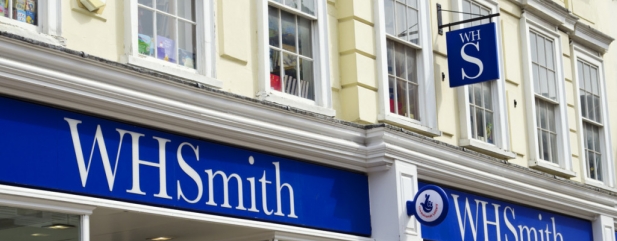Archived article
Please note that tax, investment, pension and ISA rules can change and the information and any views contained in this article may now be inaccurate.
Buy WH Smith for its underappreciated retail strengths

WH Smith’s (SMWH) ability to keep growing its travel arm despite tough retail conditions begs the question whether the stock has been incorrectly priced. We think it should command a high equity rating and are confident the share price has much further to rise.
The travel arm accounts for 61% of group profit and encompasses its stores in railway stations, airports, hospitals and motorway service stations. These sites benefit from having a captive audience, namely people who don’t have the luxury of being able to shop around for a better price.
If you’re waiting to get a train, you may only have a few minutes to quickly buy a few snacks, a magazine or book and potentially something for your children, and so you may not grumble about the price. And with a motorway service station there isn’t anywhere else to go to buy the products sold by WH Smith so you either spend money in its shop or go away empty handed.
This rare position means it is able to charge more for its products in the travel arm and exploit the captive audience.
SOUNDS FAMILIAR?
This situation is very similar to SSP (SSPG), a multinational company which operates branded catering and retail units at airports and railway stations around the world.
SSP is responsible for many of the food and drink units at these sites including some operating under third party brands such as M&S Simply Food, Starbucks and Leon which it runs as under franchise agreements.
Investors have flocked to own shares in SSP since it joined the stock market in 2014 to capitalise on its market advantage. Its shares now trade on 25.4 times forecast earnings for the year to September 2019. In contrast, WH Smith trades on a 32% discount with a forward PE of 17.3 for the year to August 2019.
The question to ask is whether WH Smith should command a rating more in line with SSP? Let’s consider this situation. First of all, WH Smith does deserve to have some discount to reflect the challenges of having high street stores.
Approximately 39% of group profit comes from the high street where like-for-like sales have fallen at a 10-year compound annual growth rate of 4%, says Mirabaud analyst Jonathan Fyfe. However, a shift in the type of products being sold and various cost savings initiatives have led divisional margins to double even as revenue has fallen.
‘Through cost action and evolution of their offering, divisional margins have increased from 4.6% in 2007 to 10.2% in 2017,’ says Fyfe. ‘Management have already identified a pipeline of £18m of additional cost savings. Management are also investing to keep their stores relevant.’
The latter comment is particularly important. WH Smith has developed a bad reputation for having shabby stores so spending money to improve their look could be a significant earnings driver.
EVIDENCE OF CHANGE
We note comical Twitter account @WHS_Carpet recently posted pictures of refurbished stores which show a clean, modern retail outlet. That’s a far cry from its usual pictures of WH Smith stores with gaffer tape to hold the carpet together and messy displays.
WH Smith said in its latest trading update (6 June) that it continues in invest in new store format trials and its eleventh standalone bookshop has just opened.
A move away from DVD and CDs in favour of higher margin products like stationery is proving to be a successful strategy. And adding Post Office counters to its stores is helping to keep the business relevant to local communities, even if it means given up some selling space.
The plan for the high street division is to deliver sustainable profit growth. As such, we don’t believe the market should impose a 32% valuation discount versus SSP because of the high street exposure.
DESERVES A HIGHER RATING
We believe WH Smith should trade more towards 20 times earnings given its superior track record in both cash generation and rewarding shareholders. Anyone investing in its shares five years ago would have made more than four times as much compared to a FTSE 100 tracker in the same period, if all dividends were reinvested.
Over the past 10 years the group has returned £860m of cash to shareholders and reduced the outstanding number of shares by circa 40%.
The travel arm has certainly played an important role in WH Smith’s underappreciated success. It commands 15.4% margins and has enjoyed 10% compound annual growth in operating profit over the past decade.
Just over one quarter of the travel stores are located outside the UK, typically in airports. There is competition from incumbents but it does have a pipeline of 40 new concessions that have been won and which are not yet open.
Other growth opportunities include a new format that combines retail with a coffee bar. This should enable it to open stores in smaller regional rail stations which were traditionally too small to justify a standalone shop.
WH Smith has plenty of initiatives underway to drive earnings and while previous efforts haven’t all been successful – specialist card shops didn’t amount to much – the exit costs have never been material, says stockbroker Numis.
So the next time you go on a plane, train or car journey and bemoan WH Smith’s high prices, why not turn the tables and invest in the company in order to benefit from its strong profits. (DC)
Important information:
These articles are provided by Shares magazine which is published by AJ Bell Media, a part of AJ Bell. Shares is not written by AJ Bell.
Shares is provided for your general information and use and is not a personal recommendation to invest. It is not intended to be relied upon by you in making or not making any investment decisions. The investments referred to in these articles will not be suitable for all investors. If in doubt please seek appropriate independent financial advice.
Investors acting on the information in these articles do so at their own risk and AJ Bell Media and its staff do not accept liability for losses suffered by investors as a result of their investment decisions.
Issue contents
Big News
- Sopheon soars past share price expectations
- Predator may be first of many to circle Inmarsat
- Windows upgrade boon for Computacenter
- This week’s most important macro stories
- Profit margin fears dog housebuilders
- Why Playtech’s acquisition of Snaitech is a potential game-changer
- Jurassic-sized expectations for Frontier Developments

 magazine
magazine













